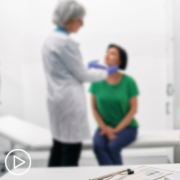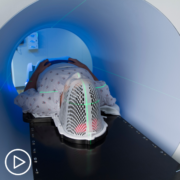Head & Neck Cancer Treatment Decisions: What’s Right for You? from Patient Empowerment Network on Vimeo.
When considering treatment options for head and neck cancer, what helps determine the best approach for YOU? Dr. Ari Rosenberg discusses key factors that impact head and neck cancer treatment decisions, emerging research, and tips for partnering with your healthcare team.
Dr. Ari Rosenberg is a medical oncologist and assistant professor of medicine at The University of Chicago Medicine. Learn more about Dr. Rosenberg.
Download Resource Guide
See More From The Pro-Active Head and Neck Cancer Patient Toolkit
Related Programs:
Transcript:
Katherine:
Hello, and welcome. I’m Katherine Banwell, your host for today’s webinar. In this program, we’re going to help you learn more about head and neck cancer. What it is, how it’s treated, and we’ll share tools to help you work with your healthcare team to access the best care.
Before we meet our guest, let’s review a few important details. The reminder email you received about this program contains a link to a resource guide. If you haven’t already, click that link to access information to follow along during the webinar. At the end of this program, you’ll receive a link to a program survey. Please take a moment to provide feedback about your experience today in order to help us plan future webinars.
Finally, before we get into the discussion, please remember that this program is not a substitute for seeking medical advice. Please refer to your healthcare team about what might be best for you. Well, joining us today is Dr. Ari Rosenberg. Dr. Rosenberg, welcome, would you please introduce yourself?
Dr. Rosenberg:
Thanks so much, Katherine, for having me on the webinar. So, having introduced myself, my name is Ari Rosenberg, I am a medical oncologist focused on the treatment of head and neck cancer.
Katherine:
Excellent. And where are you based?
Dr. Rosenberg:
So, I practice out of University of Chicago, in Chicago, Illinois, and practice as part of a multidisciplinary head and neck cancer team, including head and neck surgeons, radiation oncologists, and many other support members of the treatment team.
Katherine:
Great. Thank you so much for taking the time to join us today, we really appreciate it.
Dr. Rosenberg:
Absolutely.
Katherine:
Well, let’s start by understanding what head and neck cancer is. Is it a group of cancers?
Dr. Rosenberg:
Yeah, that’s a great question. So, head and neck cancer is really any type of cancer that develops from the head and neck area. Generally arising from sometimes the mouth, the throat, the voice box are some of the more common areas, but even the sinuses or the nasal cavities are some other areas where head and neck cancer can arise.
The majority of head and neck cancers are actually called squamous cell carcinoma. About 95 percent are squamous cell carcinomas, and they tend to arrive from the mucosal lining of some of these different parts of the head and neck area.
However, the other 5 percent are other types of head and neck cancers, such as salivary gland cancers, or other rare types of cancers that can also arise in the head and neck.
And within head and neck squamous cell carcinoma, there’s really two different types that we think about – in 2023 at least. One is HPV-associated squamous cell carcinoma of the head and neck, which is associated with a virus called HPV, or human papillomavirus. And, of course, we also see HPV-negative, or non-HPV-related cancers, which are the squamous cell carcinomas of the head and neck that can be associated, for example, with smoking or alcohol as the major cause of effect.
Katherine:
How is head and neck cancer staged?
Dr. Rosenberg:
Yeah, so after the diagnosis of head and neck cancer, there’s generally a number of tests that are done to determine where it spreads to.
Where it started, where it spreads to, to figure out what the best treatment approach is. So, oftentimes, that starts with a physical examination, often in combination with an ENT, or a head and neck surgeon. Oftentimes, that will involve endoscopy, which is a camera that the ENT uses to look very closely and carefully on the extent of the tumor itself.
Additionally, we generally tend to use imaging as well, in order to stage or determine the extent of where the tumor might have spread to. Oftentimes, that involves imaging of the head and neck, of course, so that’s sometimes a CT scan, or an MRI scan. Oftentimes, it involves imaging of the chest to see if there’s been any spread to the chest or the lungs, that’s oftentimes a CT scan of the chest.
And typically, that also involves, in many cases, a PET CT scan, which is a specialized scan that actually looks at the whole body and identifies where, in as precise a manner as we can determine, where the cancer has spread to.
So, I would say that’s generally the overview. Some of the subtypes may have some other tests that may be specific to your specific scenario, but I think those are some of the more general staging evaluations that we do.
Katherine:
Okay, good. There can be a number of people on a head and neck cancer patient’s care team. Would you give us an overview of who these team members might be, and what their roles are?
Dr. Rosenberg:
Yeah, absolutely. And this is one thing, actually, that I enjoy about treating head and neck cancer which is that because of the complexity of the head and neck in general, cancers that arise really do require a multidisciplinary team to figure out what the best treatment approach is.
And not only that, but most of the treatment plans that we incorporate for the treatment of head and neck cancer involve a very large and robust support team that provide different perspectives and help in optimizing outcomes for patients.
So, the three types of oncologists in our program, for example, all new patients that come in meet all three of these types of oncologists. So, one is an ENT, or a head and neck oncologist, or a head and neck surgeon, that’s one important member of the team. The second is a radiation oncologist. So, a radiation oncologist is the team member that uses radiation to treat head and neck cancer. And the third is someone like myself, a medical oncologist. We’re the ones that do the chemotherapy, or other types of systemic therapy, or other types of things like that.
And those are really the three tools, and the three oncologists that use those tools to figure out what the best treatment approach is. However, because many of the treatments that we give, whether it’s surgical treatment, or whether it’s some combination of chemotherapy and radiation, or of chemoradiation, there are many side effects of treatment. And as such, there are many other team members that are involved in supporting patients and optimizing outcomes through any of those treatment modalities.
So, that oftentimes involves specialized nursing, speech and swallow doctors and pathologists, dentistry, and prosthodontics. Sometimes other types of surgeons are involved, like neurosurgeons, or skull-based surgeons, or nasopharynx surgeons as well.
As well as nutrition and dietician, physical therapy, psychosocial supportive services. I’m probably missing many, but on and on, really are all involved in the care of patients during treatment. And not only that, but even in the non-patient facing side, there are other team members also that are very important that a patient may not meet, such as the pathologists that help us determine the subtype of the cancer, whether it’s HPV related or not. Sometimes some of the genomic makers and things like that that can be very important, or immune markers that are very important for treatment decisions.
We have radiologists that have expertise in the head and neck space that help us determine exactly the extent of the disease and look at the imaging in a multidisciplinary fashion. Again, I probably missed some of the team members offhand, but yes, it’s definitely a team sport, which is really, really important.
Katherine:
Yeah, it sounds like there’s a lot of people involved in helping care for patients. I’d like to pivot now to talk about treatment options for head and neck cancer. What types of treatments are currently available?
Dr. Rosenberg:
Yeah, so it depends on lots of factors, and part of that is the type, and the stage, and the location, and things like that, but I can give some general perspectives. For very early-stage head and neck cancer, oftentimes, the treatment is either surgery or radiation alone, oftentimes some of the treatments. However, a lot of times, head and neck cancer can be local regionally advanced, or having spread to some of the local areas, such as lymph nodes within the head and neck space, and there it’s quite variable.
Sometimes patients will get surgery first, followed by – depending on some of the specific factors – radiation, or radiation and chemotherapy afterwards.
And oftentimes, for local regionally advanced head and neck cancer, treatment can include non-surgical therapy, such as chemoradiation, or chemotherapy and radiation-based approaches. And then, of course, for more advanced cases, either cases of head and neck cancer that either come back after treatment, or in cases that have spread to other parts of the body, we have other therapies, such as immunotherapy therapy, or immunotherapy with chemotherapy, or some of those kinds of treatment. So, generally, those are some of the options. But again, with head and neck cancer, it’s extremely personalized.
The most important thing is that a multidisciplinary team is able to review the case as a group to figure out what type of treatment approach will optimize not only the likelihood of cure and survival, but also long-term function and quality of life. And whatever treatment modality is needed to achieve those goals, that’s what should be recommended with that type of multidisciplinary team.
Katherine:
Yeah. Dr. Rosenberg, you touched upon this just a moment ago, but I would like to ask you to this question. Are the options different in any way for advanced or metastatic disease?
Dr. Rosenberg:
So, the answer is yes, and the short answer is it depends. But I think the longer answer is that we have therapies that have been shown in more advanced disease, and we’re really talking about cases where cancer has come back, or has spread to other parts of the body, where we have new treatments that help patients in that challenging situation live longer. The main one has been the development of immunotherapy as a treatment option, either alone or in combination with chemotherapy, and that has really improved outcomes for patients with very advanced head and neck cancer treatment and cases.
Katherine:
What about palliative care? How can it help people with head and neck cancer?
Dr. Rosenberg:
Yeah, so, I’ll start by defining palliative care, which I sort of would suggest is either a treatment team, or strategies to help palliate, or relieve, the symptoms associated with cancer, or with cancer-related treatment, which unfortunately for head and neck cancer can be quite substantial. The location of cancers in the head and neck space can have a very large impact on pain, quality of life, speech, swallowing function, and man, many more. And the treatments as well, chemoradiation, surgery, things like that in the head and neck space can also have major impacts on quality of life, and some of those symptoms that patients can experience.
So, oftentimes, management of those treatments – whether with appropriate pain medicines, medicines to help with some of the other side effects of treatment – even support for speech therapies, swallowing therapy, physical therapy, therapy to help with lymphedema, or some of the swelling that can occur with treatment – can all be very, very, very important.
So, when patients come to my clinic, we spend much of the time discussing the treatment, and making sure that the treatment against the cancer is the right thing. But also, quite a bit of time focusing on what other things do we have to do to optimize that patient’s outcome, both in terms of survival, as well as function and quality of life.
Katherine:
Yeah. Well, that leads us to my next question, which is where do clinical trials fit in?
Dr. Rosenberg:
Yeah. So, clinical trials are really important for head and neck cancer because as much as we have tools to treat the disease, the tools that we have are suboptimal.
They’re what we have, they’re what we use, and they can be quite successful in many cases, however, we can do better. We need better treatments for head and neck cancer. So, broadly, the clinical trials can actually be across multiple different treatment settings, whether earlier stage disease, or later stage disease. And the goal of the clinical trials are often to develop better treatments. What can that mean? Treatments that work better against the cancer, so help patients live longer with better quality of life.
Sometimes clinical trials evaluate strategies to reduce the toxicity, or the side effects associated with treatment, so many trials are trying to evaluate strategies to reduce some of those kinds of side effects with the treatment. And then many trials are also trying to use, for example, new biomarkers, or new tests, which can help sometimes predict which is the right treatment for the right patient.
One patient may need a more aggressive treatment, one may need a less intensive treatment. So, at our center, for example, we have clinical trials that, depending on the particular circumstance for those patients, that are trying to take what we have as the current standard, and build on that, to either improve survival and outcomes for patients, or reduce side effects, or both in order to optimize patient outcomes.
Many of our clinical trials incorporate new immune therapies. So, immune therapy treatments are strategies that harness the body’s immune system to attack cancer, and we’re trying to identify new ways to do that. Some of our clinical trials are focused on trying to make the radiation, or the chemotherapy and the radiation, a bit more precise, and focused on the specific tumor. And some are focused on identifying what the best treatment would be for one particular person’s tumor, because we know that actually it’s many different diseases.
And so, we want to really figure out what the optimized treatment is for giving patients that increases survival while reducing treatment-related toxicity. Again, that’s really the overarching goal of what we’re trying to achieve with clinical trials for head and neck cancer.
Katherine:
Yeah. What about emerging approaches for treating head and neck cancer? Is there research going on that patients should know about?
Dr. Rosenberg:
Yeah, definitely. So, many new drugs are being developed for head and neck cancer with many different treatment strategies. I would say given the success of immune therapy recently for head and neck cancer, and other cancer types as well, many are trying to build on that, and identify better immune therapies that work better against cancer therapies. Some are targeted therapies, so developing new drugs that maybe target a specific mutation, or a specific change in a particular patient’s tumor that would be appropriate.
And the other thing that is being developed is strategies that incorporate, for example, blood tests that can sometimes measure tumor DNA in blood in a non-invasive fashion that can reveal all sorts of specific information about that particular patient’s tumor, how they’re responding to therapy, and can hopefully help optimize and personalize therapy. So those are some of the more emerging approaches that are being developed in clinical trials for head and neck cancer.
Katherine:
That’s encouraging, thank you. Well, we’ve covered treatment approaches, let’s talk about treatment goals. What are the objectives of treatment?
Dr. Rosenberg:
Yeah, so really, I would put them in sort of two different categories when you think about the goals of treatment. Number one is survival, or, if possible, achieving a cure, right? Cure meaning a treatment that five, 10, 15, 20 years down the road, we don’t see any evidence of recurrence, and trying to give the best opportunity for that.
And living as long as possible for patients, I think, is the number one goal, and we do that with identifying the most effective treatments and support for a given head and neck cancer in a given situation. However, the other very, very important goal of treatment is to optimize long-term function and quality of life. Because in the setting of a very effective treatment against the cancer, we also want patients to have good function. What does that mean function? Speech, swallowing, ability to eat, taste. Have those things that are very, very important for quality of life, and we want to figure out whatever tools we need to achieve both of those goals, and optimize both of those goals, which can be different from patient to patient.
Katherine:
Yeah. Well, what factors are considered when choosing a treatment?
Dr. Rosenberg:
So, first of all, we think about the diagnosis, right? Is this a squamous cell carcinoma, or is this a different type of cancer, like a salivary gland cancer, or a thyroid cancer, because those are treated very differently. In terms of squamous cell carcinoma, we use the information about whether it’s HPV or non-HPV-related head and neck squamous cell carcinoma, and that has major implications for prognosis, and, therefore, potential treatment or clinical trial options.
We also think about the location of the tumor, and the extent, and the stage. So, is this is a very small tongue cancer, or is this a very large cancer that started in the back of the throat that has already spread to lymph nodes? Both of those, obviously, would be very different treatment options. So, location, and the extent of spread.
Oftentimes, treatment considerations need to take into account – or always, I would say – take into account a patient’s specific factors. How old, other medical problems, other medications, previous treatments that patients have received, are very, very important. And then today, in 2023, we have many targeted molecular characterizations, so we can actually obtain a lot of information from the tumor itself that can also help identify the biological character that can help predict which is the right treatment for a given patient.
So oftentimes, that means looking for genetic mutations, HPV DNA in tumor, or immune markers, such as PDL1, which is an immune marker that we use to predict responsiveness to immunotherapy. These are all datapoints that come into our evaluation to identify what the best, really unique, treatment approach would be for a given patient.
Katherine:
What about symptoms and side effects? What should people be worried about?
Dr. Rosenberg:
Yeah. So, oftentimes when patients come to us with a new diagnosis of head and neck cancer, when looking back, they’ve had, sometimes, symptoms for a while, whether it’s a nagging ulcer on their tongue, or some difficulty with speech, or a new hoarseness, or a lump in the neck that turns out to be a cancerous lymph node.
And so, even before we get into the diagnosis of head and neck cancer, I do think it’s important for people to know that, in particular, if some of these symptoms – particularly if they’re lasting for a while and not going away with more conservative measures like antibiotics – really need to be evaluated by an ENT and a doctor team to make the diagnosis of head and neck cancer, so it can be treated.
The side effects of treatment very much depend on the treatment modality that’s used. So, for example, when chemotherapy and radiation, and chemoradiation is utilized, oftentimes, the treatment itself could be associated with a lot of side effects from treatment. Things like a sore throat, things like skin changes, things like fatigue, challenges with nutrition, and a plethora of other things that, depending on some of the specifics, can be associated. Which is one of the reasons why we’re trying to figure out if there are some patients that we can deintensify the radiation, or do more precise radiation, rather than standard, regular dose radiation for everyone. But that’s of course in the context of some of the clinical trials that are being evaluated for improving outcomes for head and neck cancer patients.
Katherine:
Yeah. What do you feel is the patient’s role in making treatment decisions?
Dr. Rosenberg:
Very important. You always discuss the situation of the patient, in terms of their cancer. What their diagnosis is, what some of these characteristics are, what the staging is, what the extent of disease is. And then we talk to the patients about what their goals are, what’s most important to them, and figuring out what the treatment paradigms are that help to meet those goals.
And so, it’s very, very important, and it’s very important that patients have a conversation with their oncology treatment team for head and neck cancer about what their goals, what’s most important to them, and how they can best achieve those goals in the context of head and neck cancer treatment planning.
Katherine:
Yeah. So, it sounds like there’s a lot of factors taken into consideration then.
Dr. Rosenberg:
Definitely.
Katherine:
I’d like to turn to self-advocacy now. If a patient is feeling uncomfortable with the direction of their treatment plan or their care, do you think they should consider a second opinion, or even consult a specialist?
Dr. Rosenberg:
So, yes. I think, especially if a patient is feeling uncomfortable, it is always a good idea to get a second opinion, and to have another fresh set of eyes evaluate the case. Whether it means that that second opinion will reinforce the plan and give the patient more confidence in the plan that was proposed, or whether it means a potentially alternative plan that may be suggested for different reasons. And that allows the patient to have the autonomy and the facility to be able to help figure out which of the treatment team that is most appropriate for them.
At the end of the day, head and neck cancer doctors want what’s best for patients. They want patients to do well, and that means that supporting patients in whatever – they want to do what will be best for them. I think all of us want that for patients. I think that’s definitely the case.
Katherine:
Yeah. What would you say to patients who may be nervous about maybe hurting their doctor’s feelings by getting a second opinion? Can you reassure them in some way?
Dr. Rosenberg:
Yeah. I mean, I would say that you shouldn’t worry about that, because doctors really do truly want their patients to do well. We go to this field because we want to help people, we want to help patients do better. And oftentimes, that means second opinion. So, I could tell you that I’m highly supportive of that.
And the other thing I’ll just say is that head and neck cancer is a really specialized type of cancer, in terms of cancer treatment. And so, it is a good idea, in my view, and in my opinion, to be evaluated by an experienced head and neck cancer treatment team. One of the treatment teams that tends to see a very large volume, has a lot of experience treating head and neck cancer because that experience, I do think, is important for optimizing treatment outcomes.
Katherine:
If a patient is having a difficult time voicing their questions or their concerns, are there members of the support team who might be able to help?
Dr. Rosenberg:
Yeah, so there’s lots of phenomenal organizations that can help direct, because it’s a complex navigation that’s difficult for anyone, particularly in a patient with a new head and neck cancer diagnosis. The Head and Neck Cancer Alliance is one that comes to mind, but there’s many support groups for patients.
And so, I would suggest if there’s uncertainty, those groups are available to help patients help to navigate the system. And so, I think that would be one area where patients could reach out to, which is patient advocacy organizations, patient advocates, in order to help to navigate whatever the patient wants, whether it’s a second opinion, whether it’s support, whatever’s needed to see what’s out there. Because again, we all want patients to do well and want to support patients however we need to in order to optimize some of those outcomes that I talked about earlier.
Yeah. So, in our program, for example, we have experienced nurse navigators that help coordinate all the care at our center, but also help direct.
Because the best person to talk to may be the speech pathologist, depending on the question, or it may be the psychosocial team, or it may be the surgical team or the radiation oncology team. A lot of times, a nurse navigator or a point person for questions can help direct who’s the best person to address that particular question. Sometimes those questions are best addressed by social work and supporting patients through that.
So, I would suggest asking when you get your consultation, “Who’s my point person for questions? If I have a question, and I don’t know who the right person is to ask, who do I pose that to, to make sure that it gets pointed to the right person?”
Katherine:
Right. To close, what would you like to leave the audience with? Are you hopeful about the future of head and neck cancer?
Dr. Rosenberg:
I am. I think that there’s lots of exciting things in the pipeline that are leading to what I hope will be improved treatments for head and neck cancer that optimizes survival, but also optimizes long-term function and quality of life. And so, I hope that, Katherine, when you and I speak in 10 or 20 years, we’ll be in a totally different place, a totally different landscape, thinking about totally different things than we are today, to really optimize outcomes for patients. So, we’ll talk within in 20 years, or maybe sooner, whatever works for you.
Katherine:
Yeah, things are changing so rapidly, aren’t they? Yeah. Well, Dr. Rosenberg, thank you so much for taking the time to join us today.
Dr. Rosenberg:
Absolutely, thanks so much.
Katherine:
And thank you to all of our partners.
If you would like to watch this program again, there will be a replay available soon. You’ll receive an email when it’s ready. And don’t forget to take the survey immediately following the webinar, it will help us as we plan future programs.
To learn more about head and neck cancer, and to access tools to help you become a proactive patient, visit powerfulpatients.org. I’m Katherine Banwell, thanks for joining us today.
























